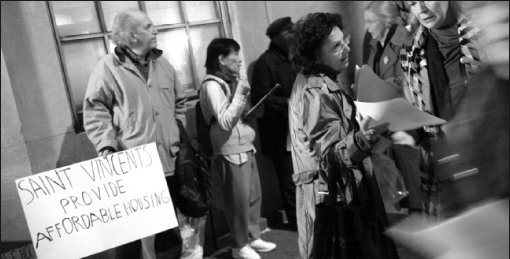By Albert Amateau
The Village Independent Democrats’ demonstration on Nov. 14 for including affordable housing in the St. Vincent’s Hospital/Rudin Organization redevelopment was low-key compared to the a meeting of the hospital’s Community Working Group that followed, at which hecklers showed no restraint.
Working Group members, who have been meeting with hospital officials for nearly a year, gathered again on Nov. 14 protesting that the 330-foot-tall, new hospital building proposed for the west side of Seventh Ave. and the proposed 265-foot-tall residential tower on the avenue’s east side would overwhelm the neighborhood.
“Your enormous building will overshadow my apartment. I’ll be in a canyon of darkness,” said one woman who lives on the top floor of a six-story building across from the six-story O’Toole Pavilion, the site of the proposed new hospital building.
Gary Tomei, a 13th St. resident, said he thought the hospital’s efforts to make the community part of the consulting process rang hollow.
“You knew you were going to build a gargantuan building,” he said.
The Rudin residential component, intended to provide St. Vincent’s with more than $300 million to defray the estimated cost of $700 million to $800 million to build the new hospital, was also a target of neighbors’ ire.
Marilyn Dorato, president of the Greenwich Village Block Associations and a Community Working Group member, wanted to know if Rudin’s profit margin in the project was driving the size of the residential component.
“You’re busting the Greenwich Village Historic District,” she said.
Andrew Berman, executive director of the Greenwich Village Society for Historic Preservation, said that St. Vincent’s yearlong meetings with the Community Working Group have not resulted in any concessions to community wishes.
“This would be the biggest project in the Greenwich Village Historic District,” Berman said. “I don’t see a lot of changes in the project.”
St. Vincent’s replied in an e-mail last week about the Working Group’s effect on the project. In response to neighbors’ concerns, St. Vincent’s — in partnership with the New York Horticultural Society — will create and maintain a public green space on the triangle across from the proposed new medical center. Nineteen low-scale townhouses planned for the midblocks on the east side of the avenue were also cited as a response to community concerns about the integrity of the Greenwich Village Historic District. St. Vincent’s also noted that it is seeking the relocation of 91 of its psychiatric beds to the Cabrini Hospital site on E. 20th St.
Carol Greitzer, a former city councilmember and a W. 12th St. resident, said at the Nov. 14 meeting that she was outraged at The New York Sun’s Nov. 13 editorial in favor of the project.
In the line most offensive to the project’s opponents, The Sun’s editorial said: “If historic preservation fanatics had their way [the historic district] would be preserved unchanged forever as if embedded in amber while patients were still being treated by being bled by leeches.”
Working Group members angrily charged that hospital and Rudin officials were responsible for the “fanatics” and “bled by leeches” rhetoric in the editorial and demanded St. Vincent’s send a letter to The Sun disavowing the editorial. Indeed, they virtually stopped the meeting until Bernadette Kingham-Bez, St. Vincent’s senior vice president, said she would write to The Sun about editorial.
Nevertheless, Kingham-Bez said the hospital was not responsible for the way the editorial was written. John Gilbert, Rudin chief of operations, said The Sun received the same presentation of the project that the community received.
Gilbert said there would be a total of between 375 and 415 residential units on the east side of Seventh Ave. in the residential tower as well as the midblock townhouses proposed for W. 11th and W. 12th Sts.
“I can’t be any more accurate because it’s six years in the future and no one can tell what the market will be,” Gilbert said.
The economics of Manhattan construction compels all the residential units to be market-rate condos — with no rental units and no subsidies for affordable housing — Gilbert said.
“Bill Rudin led the charge in Washington for bonding capacity to allow more 80/20 housing to be built,” Gilbert said. He was referring to a federal program under which developers get tax breaks in return for making 20 percent of their projects affordable. But Rudin’s effort to increase this sort of housing was in vain, he said.
The V.I.D. demonstrators, however, had said that affordable housing was a crucial issue for the project.
“We talk about landmarking buildings,” said Keen Berger, Village Democratic co-district leader and a V.I.D. member. “But I think we have to landmark people. The thing that makes the Village is the people, and that’s what we have to protect and preserve with housing they can afford.”
Brad Hoylman, Democratic co-district leader with Berger and chairperson of Community Board 2, said permanent affordable housing as part of the city’s Inclusionary Housing Program has been included in large-scale development proposals in Williamsburg, Brooklyn, and on the former Con Edison site on First Ave. between E. 38th and E. 42nd Sts.
“Affordable housing really has to be on the table in the St. Vincent’s project,” Hoylman said.
The project will go before the Landmarks Preservation Commission at the end of the year or at the latest in January to determine if it is appropriate for the Greenwich Village Historic District. The project then will begin the 18-to-24-month uniform land use review procedure, or ULURP, through the City Planning Commission, including an environmental impact statement and public hearings, with the City Council having final approval.






































